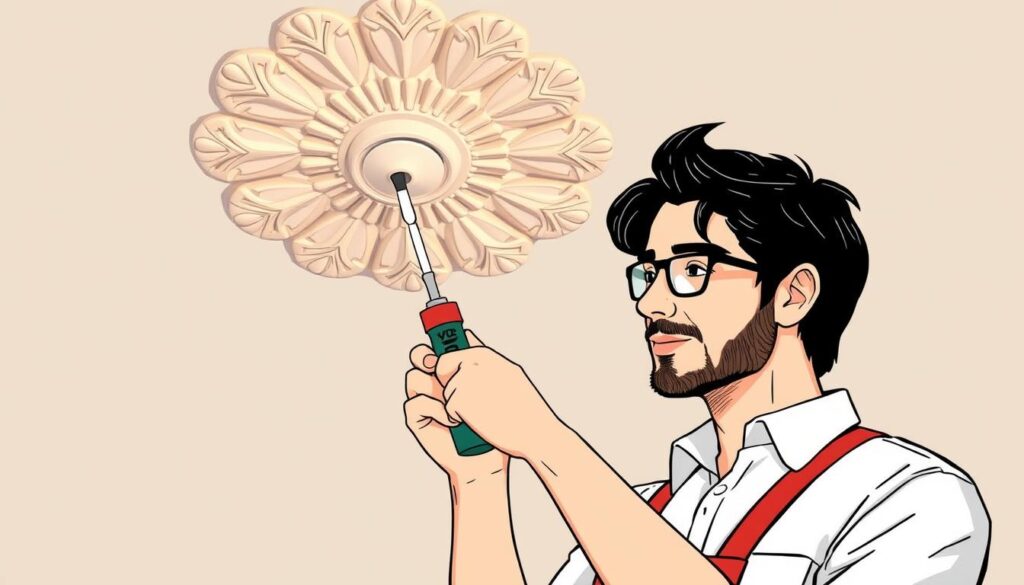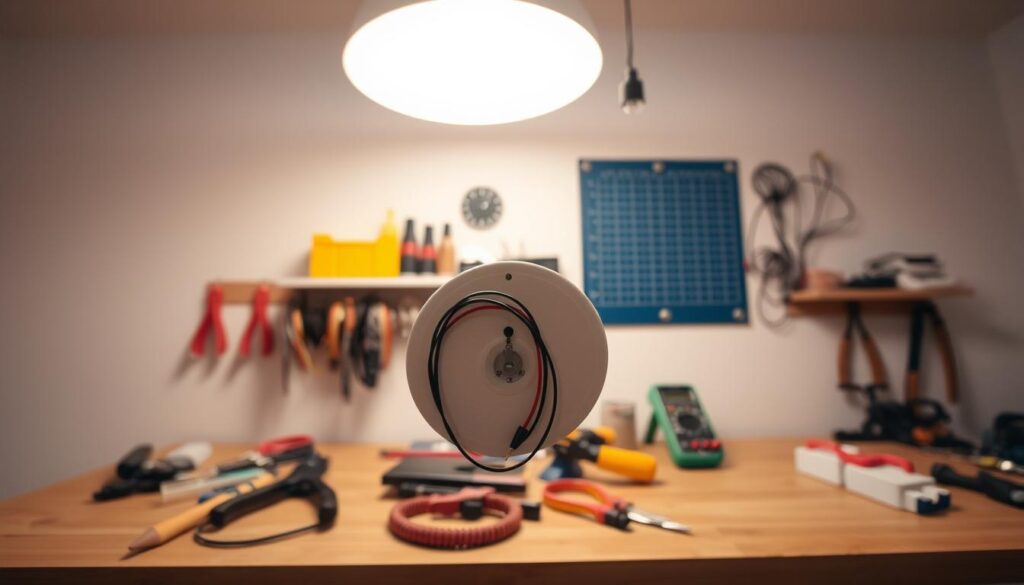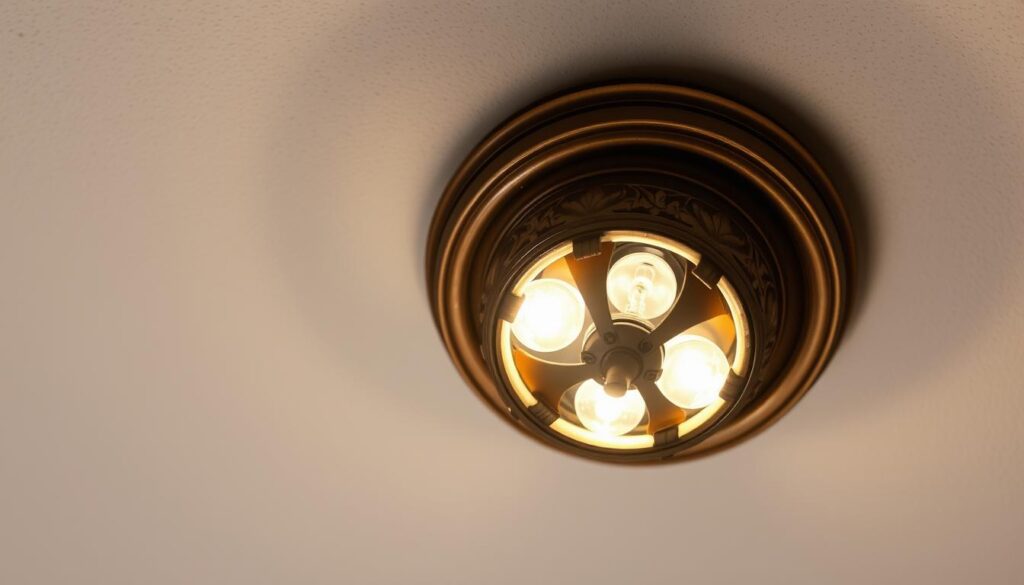Are you wondering if you can safely update your home’s light fitting without calling an electrician? Replacing a ceiling rose can seem daunting, but it’s a task you can accomplish with the right guidance.
Outdated or damaged wiring can be a hazard in your home, especially in older properties. This comprehensive guide will walk you through the process of safely replacing your ceiling rose wiring, covering everything from understanding the different wiring colours used in the UK to the final testing of your new installation.
Key Takeaways
- Understand the different wiring colours used in the UK pre-2004 and current standards.
- Learn how to identify and connect wires correctly to prevent electrical hazards.
- Discover when to tackle this job yourself and when to call a professional electrician.
- Select the right ceiling rose light for your lighting needs.
- Complete the replacement in under 30 minutes with proper preparation.
Understanding Ceiling Rose Wiring
Before diving into the replacement process, let’s explore the basics of ceiling rose wiring. A ceiling rose is a critical component of your home’s lighting system, serving both functional and decorative purposes.
What is a Ceiling Rose?
A ceiling rose is a decorative fitting that connects your ceiling light to the electrical wiring in the ceiling. It houses the electrical connections and provides a secure mounting point for your light fixture. The basic components include the base plate, terminal block, and lamp holder.
- A ceiling rose serves as both a functional and decorative element in your home’s lighting system.
- It connects to your home’s electrical circuit and distributes power to your light fixture.
Common Reasons for Replacement
Common reasons for replacing a ceiling rose include damaged connectors, exposed wires, broken parts, or simply updating to a more modern design. Over time, older ceiling roses can deteriorate, potentially creating safety hazards. Replacing an outdated ceiling rose can improve both safety and aesthetics in your home.
- Signs that indicate your ceiling rose needs replacement include cracked casings or loose connections.
- Understanding the difference between a ceiling rose and other light fittings is crucial when purchasing replacements.
Safety Precautions Before You Begin
Safety should always be your top priority when working with electrical installations in your home. Electrical work can be hazardous if proper precautions are not taken. Always turn off the power supply before starting any work to avoid electrical shock or other accidents.
Turning Off the Power Supply
To ensure your safety, you must switch off the power at the consumer unit or fuse box. It’s not enough to just turn off the light switch; you need to verify that the circuit is dead using a voltage tester. This step is crucial in preventing electrical shock. “Working with live electricity is extremely dangerous and can be lethal,” as emphasized by electrical safety experts.
- Locate your consumer unit or fuse box and identify the correct circuit breaker or fuse controlling the lighting circuit you’re about to work on.
- Switch off the power and test the circuit with a voltage tester to confirm it’s dead.
Essential Safety Equipment
Wearing appropriate safety gear is vital when working with electrical systems. This includes insulated gloves and using VDE-rated tools designed for electrical work. Additionally, ensure your workspace is well-lit, preferably with lighting from another source, and keep ladders securely positioned.

Having someone else present during electrical work adds an extra layer of safety. Moreover, keep children and pets away from your work area to prevent accidents. By taking these precautions, you can significantly reduce the risks associated with electrical work.
Tools and Materials Needed to Replace Ceiling Rose Wiring

Gathering the correct tools and materials is a crucial step in replacing your ceiling rose wiring. Having the right equipment will make the replacement process much smoother and safer.
Required Tools
You’ll need VDE-rated screwdrivers (both flathead and Phillips) to ensure safe handling of electrical components. Additional tools include wire strippers, a voltage tester, insulated pliers, and a torch for illuminating the work area.
Choosing the the Right Ceiling Rose
For materials, you’ll need a new ceiling rose, typically a standard B22 bayonet fitting. You may also require electrical tape for marking wires and possibly connector blocks if the existing ones are damaged. Selecting a ceiling rose that matches your existing wiring configuration is essential.
Understanding UK Wiring Colours
When replacing a ceiling rose, it’s essential to understand the wiring colours used in the UK. The colour codes for electrical wiring have changed over time, particularly in 2004, which affects how you should approach this task.
Old Wiring Colours (Pre-2004)
Before 2004, the wiring colours in the UK were different from those used today. The live wire was red, the neutral wire was black, and the earth wire was green or yellow/green. You may still encounter these colours in older properties.
| Wire Type | Colour (Pre-2004) |
|---|---|
| Live | Red |
| Neutral | Black |
| Earth | Green or Yellow/Green |
New Wiring Colours (Post-2004)
Since 2004, the UK wiring colours have changed to improve safety. Now, the live wire is brown, the neutral wire is blue, and the earth wire remains green/yellow. Understanding these colours is crucial for safe installation.
| Wire Type | Colour (Post-2004) |
|---|---|
| Live | Brown |
| Neutral | Blue |
| Earth | Green/Yellow |
In some cases, you may encounter both old and new wiring colours in the same ceiling rose, especially in older properties that have been renovated. It’s essential to identify the switched live wire correctly, regardless of its colour. Using a systematic testing approach can help you work safely with unmarked or ambiguous wiring.
Step-by-Step Guide to Replace Ceiling Rose Wiring
A step-by-step guide is essential for safely replacing your old ceiling rose wiring with a new one. This process involves several crucial steps that must be followed carefully to ensure a successful installation.
Removing the Old Ceiling Rose
To begin, remove the lampshade and bulb to access the ceiling rose. Then, unscrew the ceiling rose cover to expose the wiring. It’s advisable to take photos of the existing wiring configuration before disconnecting any wires to serve as a reference for the new installation.

Identifying and Labelling Wires
As you disconnect the wires, label them according to their functions, such as “switched live,” “neutral loop,” and “live loop.” This systematic approach helps in identifying and organizing the different wire sets, making it easier to connect them to the new ceiling rose correctly.
Connecting Wires to the New Ceiling Rose
Connect the wires to the new ceiling rose following the same configuration as the old one, ensuring tight and secure connections. Typically, neutral wires connect to the terminal near the blue wire, switched live connects near the brown wire, and live wires go to the central connector. Make sure to strip the wire ends properly and tighten the terminal screws to the correct tension.
Wiring Configuration for Different Setups
When replacing a ceiling rose, understanding the wiring configuration is crucial for a safe and successful installation. Different homes may have varying electrical setups, and it’s essential to identify your specific configuration.
Standard Loop-in Ceiling Rose Wiring
In a standard loop-in ceiling rose setup, you’ll typically find three sets of wires: one switched live wire (often black in older systems or brown in newer ones), two neutral wires (blue), and three live wires (red/brown). The switched live wire connects to the terminal near the brown wire of the lamp holder, neutrals connect near the blue wire, and lives connect to the central terminal.
Dealing with Multiple Wire Sets
When dealing with multiple wire sets, you may need to use connector blocks to join wires before connecting to the ceiling rose. This is particularly common in rooms with multiple light switches or complex wiring arrangements. By using connector blocks, you can maintain the integrity of the circuit while ensuring a safe and reliable connection.
Testing Your New Ceiling Rose Installation
Testing your new ceiling rose installation is essential for safety and functionality. This step ensures that your new setup works correctly and safely.
Visual Inspection Before Powering On
Before restoring power, conduct a thorough visual inspection of your ceiling rose installation. Make sure all connections are tight, no bare wires are exposed, and the ceiling rose is securely attached to the ceiling. Check that all terminal screws are properly tightened.
Safe Testing Procedure
Install the light bulb and shade. Then, turn the power back on at the consumer unit and test the light by operating the switch. If the light doesn’t work or trips the circuit, turn off the power immediately and recheck your connections. This step is crucial to ensure your installation is safe and functioning correctly, giving you confidence in your work over time.
Conclusion: When to Call a Professional Electrician
Replacing a ceiling rose can be a DIY-friendly task, but certain situations demand professional expertise. If you encounter unfamiliar wiring configurations, damaged wiring, or signs of overheating, it’s time to call an electrician. Similarly, if you’re uncomfortable working with electricity or have high ceilings, consider hiring a professional to ensure your home remains safe.



